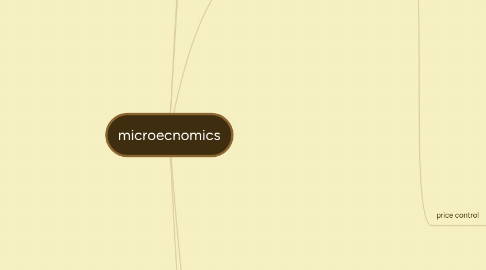
1. 1.1demand &supply
1.1. market
1.2. demand
1.2.1. law of demand
1.2.2. move along and shift
1.2.3. non-price determinants
1.2.3.1. income
1.2.3.1.1. inferior goods
1.2.3.1.2. normal goods
1.2.3.2. preference
1.2.3.3. price of related goods
1.2.3.3.1. subsititute
1.2.3.3.2. compelment
1.2.3.4. demographic changes
1.2.4. calculation
1.3. supply
1.3.1. law of supply
1.3.2. move along and shift
1.3.3. non-price determinants
1.3.3.1. FOP
1.3.3.2. technology
1.3.3.3. price of related goods
1.3.3.3.1. joint
1.3.3.3.2. competitive
1.3.3.4. expectations
1.3.3.5. indirect tax
1.3.3.6. subsidy
1.3.3.7. #of firm in market
1.3.4. calculation
1.4. market equilibrium
1.4.1. excess supply
1.4.2. excess demand
1.4.3. new equilibrium
1.4.4. calculation
1.5. price mechanism
1.5.1. opportunity cost
1.5.2. signalling/incentive function
1.5.3. reallocation of resources
1.6. market efficiency
1.6.1. consumer surplus
1.6.2. producer surplus
1.6.3. allocative efficiency
1.6.3.1. CS=PS/MB=MC
2. elasticity
2.1. PED
2.1.1. PED=(%ΔQ/%ΔP)
2.1.1.1. P elsatice demand
2.1.1.2. P inelastic demand
2.1.1.3. P unit elastic demand
2.1.1.4. perfectly elastic demand
2.1.1.5. perfectly inelastic demand
2.1.2. determinants
2.1.2.1. # and closeness of substitutes
2.1.2.2. degree of necessity
2.1.2.3. time
2.1.2.4. proportion of income spent
2.1.3. calculation
2.1.3.1. using two points
2.1.3.2. PED varies along the straight line
2.2. XED
2.2.1. XED=(%ΔQx/%ΔPy)
2.2.1.1. subsitute+
2.2.1.2. complementary -
2.2.1.3. closeness |x|
2.2.1.4. application of Biz
2.3. YED
2.3.1. YED=(%ΔQ/%ΔY)
2.3.1.1. normal goods+
2.3.1.1.1. Elastic
2.3.1.1.2. Inelastic
2.3.1.2. inferior goods-
2.3.1.2.1. Elastic
2.3.1.2.2. Inelastic
2.3.1.3. distinguish
2.3.1.3.1. necessity Y inelastic
2.3.1.3.2. luxury Y elastic
2.3.1.4. application
2.3.1.4.1. low YED for primary products
2.3.1.4.2. high YED secondary products
2.3.1.4.3. higher YED tertiary products
2.4. PES
2.4.1. PES=(%ΔQ/%ΔP)
2.4.1.1. elastice
2.4.1.2. inelastic
2.4.1.3. unit elastic
2.4.1.4. perfectly elastic
2.4.1.5. perfectly inelastic
2.4.2. determinants
2.4.2.1. FOP
2.4.2.2. unused capacity
2.4.2.3. ability to store stocks
2.4.3. low for primary commodities
2.4.4. high for manufactured products
3. government intervention
3.1. indirect tax
3.1.1. why impose
3.1.2. specificc&percentage
3.1.3. influence
3.1.3.1. consumer
3.1.3.2. producer
3.1.3.3. government
3.1.4. tax incidence
3.1.4.1. PED
3.1.4.2. PES
3.1.5. caluculation
3.1.5.1. price, quantity
3.1.5.2. consumer expenditure
3.1.5.3. producer revenue
3.1.5.4. government revenue
3.1.5.5. CS/PS
3.2. subsidy
3.2.1. why impose
3.2.2. influence
3.2.2.1. consumer
3.2.2.2. government
3.2.2.3. producer
3.2.3. calculation
3.2.3.1. price, quantity
3.2.3.2. consumer expenditure
3.2.3.3. producer revenue
3.2.3.4. gov. revenue
3.2.3.5. CS/PS
3.3. price control
3.3.1. price floor
3.3.1.1. why impose
3.3.1.1.1. eg.food/rent price control
3.3.1.2. consequence
3.3.1.2.1. shortages
3.3.1.2.2. inefficient resource allocation
3.3.1.2.3. welfare impacts
3.3.1.2.4. black market
3.3.1.2.5. non-price rationing mechanisms
3.3.1.3. influence
3.3.1.3.1. consumers
3.3.1.3.2. producers
3.3.1.3.3. government
3.3.1.4. calculation
3.3.1.4.1. shortage
3.3.1.4.2. Δconsumer expenditure=Δfirm revenue
3.3.1.4.3. gov. expenditure on surplus
3.3.2. price ceiling
3.3.2.1. same as above
4. market failure
4.1. meaning
4.1.1. fail allocative effciency
4.1.1.1. over-allocation
4.1.1.2. under-allocation
4.2. types
4.2.1. externalities
4.2.1.1. meaning
4.2.1.1.1. MPB
4.2.1.1.2. MSB
4.2.1.1.3. MPC
4.2.1.1.4. MSC
4.2.1.1.5. MSB=MSC
4.2.1.2. types
4.2.1.2.1. +/-consumption ex
4.2.1.2.2. +/-production ex
4.2.1.3. solution
4.2.2. lack of public goods
4.2.2.1. free rider problem
4.2.3. common resources
4.2.3.1. sustainablity
4.2.3.1.1. overused
4.2.3.1.2. depleted
4.2.3.1.3. degraded
4.2.3.1.4. negative externality
4.2.3.1.5. LDCs exploiation of land resources
4.2.3.2. gov. response
4.2.3.2.1. legislation
4.2.3.2.2. carbon tax
4.2.3.2.3. cap
4.2.3.2.4. trade schemes
4.2.3.2.5. technology fund
4.2.3.3. limitation
4.2.3.3.1. global nature
4.2.3.3.2. lack of ownership
4.2.3.3.3. require international cooperation
4.2.4. Asymmetric information
4.2.5. abuse of monopoly power
4.2.5.1. welfare loss
4.2.5.2. nationalization
4.2.5.3. trade liberalization
5. market types
5.1. theory
5.1.1. profit
5.1.2. revenue
5.1.3. production and cost
5.1.3.1. production
5.1.3.1.1. distinguish SR&LR
5.1.3.1.2. law of diminishing returns
5.1.3.1.3. define
5.1.3.1.4. calculation
5.1.3.2. cost
5.1.3.2.1. economic cost
5.1.3.2.2. define
5.1.3.2.3. distinguish SR&LR
5.1.4. goals
5.2. 4types
5.2.1. perfect competition
5.2.2. monopoly
5.2.3. monopolistic competition
5.2.4. oligopoly
